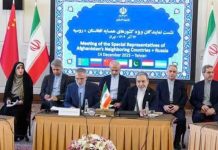Hamid Asghar Khan
Covid -19 has compelled increased reliance on Skype, Zoom and other online platforms. Many feel that these mediums, while useful, are an inadequate substitute for actual meetings. Thus, upon receiving an invitation to meet with the Moroccan Minister for Housing, Land Management & Urban Affairs Mme. Nouzha Bouchareb in person, I leapt at the opportunity.
Economies everywhere are struggling with the adverse impact of the pandemic, and Morocco, like Pakistan, views the housing and construction sectors as key to stimulating economic resurgence. A helpful series of incentives and concessions have been unveiled to kickstart housing and construction in both countries.
The Kingdom has successfully focused on equitable regional development. Instead of one or two major cities, well thought out efforts have been made to improve infrastructure, housing, business, educational and recreational facilities in all regions. This has enabled showcasing of the diverse landscape, promoting tourism attracting over a million tourists a month, contributing 10% to the national economy.
Madame Minister herself is an expert in sustainable development. She dilated upon the “Cities without slums” initiative geared to providing affordable housing for the less fortunate. It is now universally acknowledged that a key goal of modern town planning is to cap the size of large cities to limit urban sprawl. Major challenges are increased traffic, pollution, vanishing green areas, waste management, unaffordable property values and scarce water resources. All of these impact on quality of life, health and mental wellbeing.
Megapolis such as New York and Karachi were badly affected by Covid-19. The staggering density of thousands of souls living per square mile, crammed into highly urbanized areas was no doubt a factor. Conversely, the impact of Covid-19 has been far more temperate in rural and open areas.
Consequently, an increasing desire of moving to rural areas for a healthier and more relaxed lifestyle, surrounded by the purity and delights of nature is emerging. There are reports of increased interest in suburban and rural living options away from, but within commuting distance of large cities.
Sydney, Australia presents an interesting model that our Housing Authority may wish to study. The city center, known as the central business district -CBD- witnesses a huge influx in the morning, only to empty out with amazing speed in the evening as over half a million people takes buses, trains, boats, and cars and to return to their comfortable homes in the suburbs after a day’s work.
Less than 15% live within the down town city area itself, the vast majority undertake a comfortable commute to the suburbs between 20 minutes to an hour away from the CBD for quality living.
Australia, like Morocco, keeps sustainable development and environmental preservation as key goals. Thus large expanses of green belts and forested areas are maintained between self-contained small villages along train and bus lines, providing eminently manageable living clusters with adequate breathing and living space. Clinics, schools, shopping areas and other essential amenities in local living clusters preclude the need for daily travel to the city.
Our Districts in Pakistan are the optimum platform for enabling development of new living clusters. A move away from from Karachi, Lahore and Pindi-Islamabad has to be incentivized, with district governments identifying and making available suitable state land for the construction of housing, hospitals, schools, clinics, colleges, petrol pumps and markets.
The capacity to innovate is going to be a key factor in the success of our construction and housing initiatives. Karachi suffers from extraordinary challenges of waste management, water supply, traffic, storm drainage and electricity. Similar challenges are fast emerging in Lahore and Pindi-Islamabad where land cost also puts affordable housing beyond the reach of many.
The Government has done well in recent years to enhance rural connectivity by constructing a network of highways and interchanges. Consideration must be given to develop new self-contained towns in accessible rural areas, half an hour or so from major cities.
The construction of secondary and tertiary access roads in rural areas can greatly enable freeing up hitherto blocked land. Suburban clusters in districts if planned and developed as a strategy can easily address the 9 million housing unit shortage that Pakistan currently faces.This will prevent further overburdening of already overcrowded metropolis’ and will contribute to wider, broad based development of hitherto neglected areas.
Extension of public transport is essential to enable commuting. The extraordinary differential in raw land price, say between Islamabad, and the mostly uninhabited acres adjacent M2 up to Kallarkahar may be considered. If a new town were announced in this area, a shuttle train service connecting it to Islamabad could be financed through the booking of land alone. This could be a signature project for the government, generating jobs, economic activity and much goodwill in a high visibility, easily accessible area.
Thought can also be given to having themes for proposed new clusters, such as conceiving an Education Town, Health Town or Tech Town. District Government’s can identify state land for such initiatives on public private partnership basis.
Development may also be centered around pre-existing points of attraction to promote tourism and leisure activities. With the proper infrastructure Taxila could become a mecca for Budhists. We have already witnessed the attraction of the Kartarpur complex, and the many scenic lakes of Chakwal can afford tremendous leisure opportunities, as can other historic forts, temples and monuments scattered across the Potohar.
Banks are already making mortgages more easily available, but it would be beneficial to update the legal regime and enact easy repossession laws to secure loans being extended. Further incentives for the installation of solar energy grids, water harvesting, use of local finishing items, and environment friendly construction materials would help economic revival.
The state through robust regulatory oversight must ensure adequate parking, solid waste, sanitation, sewerage systems, and sufficient green areas for leisure are incorporated in projects.
A key bottleneck is access to land record. Functionaries such as patwaris, being custodians of land record must remain available at state provided offices to cater for public needs. Much work has been done to computerize records, but further effort is required to ensure transparency and efficiency at the lower end of the revenue spectrum.
Procedures for planning permissions also need simplification. Special enabling provisions for districts to develop satellite towns would be attractive not only for local dwellers, but also for workers returning from abroad, now accustomed to more modern housing facilities.
The new Housing Authority must secure inputs from the institutes of Architects and Town Planners as well as environmental experts. A careful study of the successful and sustainable development model adopted by many countries including Morocco would be beneficial. A dash of flair and imagination would come in handy as we proceed with creating attractive new living options outside of existing overcrowded cities.
We have a rich tradition in architecture. Our own Sir Ganga Ram, the famous civil engineer born in Punjab, left us with iconic architectural splendors such as Aitchison College, Lahore GPO and Lahore Museum among many others that he so ably designed and built. Heritage preservation must invariably form an integral part of the national development agenda.
It is for the new housing Authority to seize upon the mandate, incentives and facilities provided by the government, to reflect and plan on the basis of international best practices, and usher in a vibrant new era of excellence in suburban development.
The author is a Diplomat serving as Ambassador of Pakistan to the Kingdom of Morocco

















